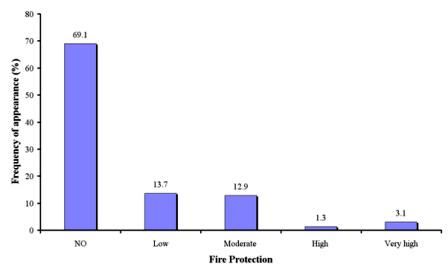Fire protection
This indicator is related to the existence of protective infrastructures against forests fires and managed natural resources. The indicator contributes to the definition of the level of control and protective management against forest fire in a territory affected by desertification processes over a long period. It has been assessed by calculating the ratio between surface of forest and other wooded land designated or planned to be protected by infrastructures and natural resources managed against fire vs. the total territorial surface area. Data have been collected from the local Forestry Department administration. The following classes have been distinguished: (a) no protection, (b) low protection, < 25 % of total surface protected/total territorial surface; (c) moderate protection, 25-50 % of total surface protected/total territorial surface; (d) high protection, 50-75% of the total surface protected/total territorial surface; (e) very high protection, >75% of total surface protected/total territorial surface.
As Table 10 shows, data on fire protection have been collected in 1141 study field sites, corresponding to 14 study sites. The dominant class of fire protection was no measures for protection at all, covering 69.1% of the study field sites. Such fire protection conditions have been defined in the all field sites of the study sites: Boteti Area-Botswana, Santiago Island-Cape Verde, Eskisehir-Turkey, Konya Karapinar plain-Turkey, Djanybek-Russia, Zeuss Koutine-Tunisia, Cointzio Catchment-Mexico and Mação- Portugal, and in few field sites of Secano Interior-Chile, Novij Saratov-Russia, Gois-Portugal, and Mamora Sehoul-Morocco. Probably in some study sites such as Novij Saratov-Russia, and Djanybek-Russia, fire protection measures were not so necessary since the climatic conditions do not favor fires. Low fire protection measures have been defined in few field sites, covering 13.7% of the total cases, and corresponding in all study fields of the study sites of Guadalentin Basin Murcia-Spain, and in few cases in the study sites of Secano Interior-Chile, Gois-Portugal, and Mamora Sehoul-Morocco. Moderate measures for fire protection have been defined in 12.9% of the study field sites, corresponding to the study sites of Mamora Sehoul-Morocco, and Crete-Greece. Finally, high and very high measures for fire protection has been defined in very few cases 1.3% and 3.1%, respectively, corresponding to the study sites of Novij Saratov-Russia, Mamora Sehoul-Morocco, and Crete-Greece.

Fig. 69. Distribution of fire protection classes defined in the study field sites